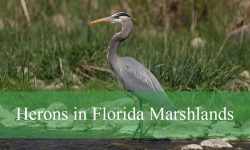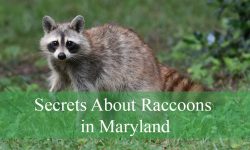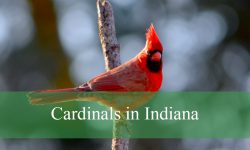Washington State is home to a wide variety of spiders, most of which are harmless and play an important role in controlling insect populations. However, a handful of species are known for their bites, which can cause anything from mild irritation to more serious symptoms.
Understanding which spiders can bite, how to identify them, and where they are most commonly found is essential for both safety and peace of mind. Many of these spiders live close to people, often inside homes, gardens, or storage areas.
This guide explores seven common biting spiders in Washington State, with pictures and identification tips to help you recognize them. By learning about their habits and bite effects, you can better coexist with these fascinating yet sometimes misunderstood creatures.
Types of Biting Spiders Found in Washington State
Hobo Spider (Eratigena agrestis)

The hobo spider is one of the most well-known spiders in Washington State, often mentioned because of concerns about its bite. It is a medium-to-large-sized spider, with adults typically ranging from 7 to 14 millimeters in body length. Its coloration is generally brown with lighter markings on the abdomen, giving it a somewhat mottled appearance. Unlike the black widow, this spider lacks any glossy shine and is more subdued in coloration, which helps it blend into its surroundings.
Identifying the hobo spider can be tricky since it resembles the giant house spider and other funnel-web weavers. One key feature is its lack of distinct dark bands at the top of its legs, and the abdomen usually shows chevron-like patterns. The hobo spider is a funnel weaver, meaning it creates a sheet-like web with a tubular retreat where it waits for prey. They are often mistaken for more dangerous species, though their bites are not considered medically significant today.
Hobo spiders prefer dark, secluded environments and are often found in basements, crawl spaces, garages, and grassy fields. Outdoors, they may be seen in tall vegetation, under rocks, and near building foundations. Indoors, they are not climbers, so they are usually spotted at ground level rather than on walls or ceilings. Their adaptability to human-made structures has made them one of the most common spiders encountered in homes.
Bites from hobo spiders are rare and typically occur only if the spider is trapped against the skin. In the past, their venom was thought to cause necrotic wounds, but more recent studies show their bite usually results in mild irritation, redness, or itching. Severe reactions are extremely uncommon. Still, their presence in homes often causes alarm, making them one of the most frequently misidentified spiders in Washington.
Giant House Spider (Eratigena atrica)
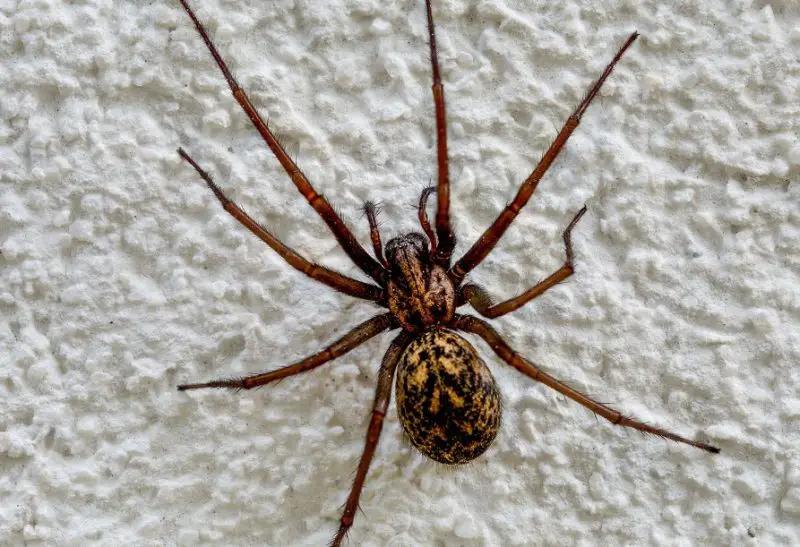
The giant house spider is a close relative of the hobo spider and is among the largest spiders found in Washington State. Adult females can have a body length of up to 18 millimeters, while males are slightly smaller. Including the legs, these spiders can appear very large and intimidating, sometimes reaching a span of 3 to 4 inches. Their coloration is usually dark brown with lighter markings on the abdomen and legs, which gives them a rugged appearance.
They are often confused with hobo spiders, but the giant house spider is even larger and typically has a more patterned appearance on its abdomen. Their legs are also longer and more robust, making them fast movers. Males are particularly noticed in late summer and fall when they wander indoors in search of females. Unlike many other spiders, giant house spiders are more visible because of their size and speed, often startling homeowners when they dash across floors.
Giant house spiders build large funnel-shaped webs in corners, basements, sheds, and other sheltered areas. They prefer undisturbed spots where they can hunt insects that wander into their webs. They are not aggressive toward humans and generally retreat when disturbed. Outdoors, they may inhabit woodpiles, stone walls, or garden debris, where their webs provide effective traps for insects.
Though their size and speed can be alarming, their bites are rare and not considered dangerous. When they do bite, symptoms are usually limited to mild pain, redness, or swelling at the site, similar to a bee sting. These spiders actually provide benefits indoors by controlling populations of flies, moths, and other nuisance insects. Despite their fearsome appearance, they are more helpful than harmful.
Yellow Sac Spider (Cheiracanthium spp.)
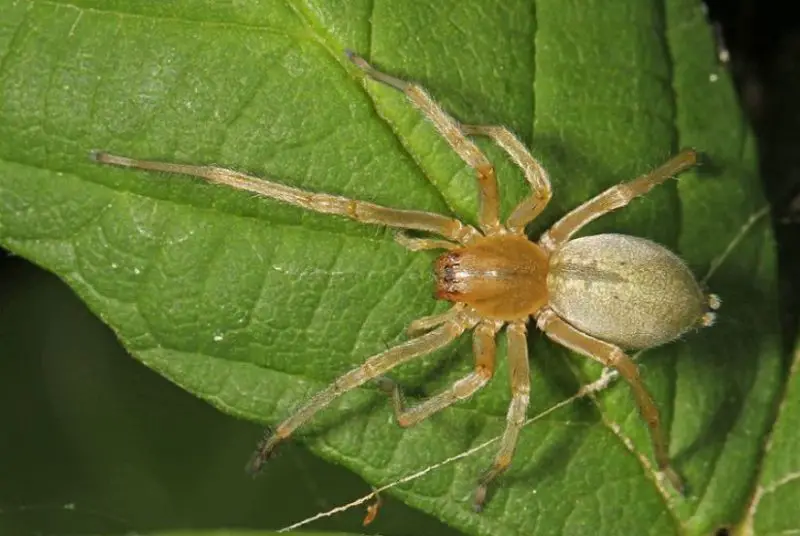
The yellow sac spider is another biting species present in Washington State, recognized for its pale yellow to greenish body color. Adults are relatively small, with body lengths between 5 and 10 millimeters, but their long legs make them appear larger. Their pale coloration and quick movements make them noticeable against walls and ceilings inside homes. These spiders are active hunters rather than web-builders, which means they roam frequently in search of prey.
Identifying the yellow sac spider can be done by its pale body, darker tips on the legs, and the tendency to create small silk sacs or retreats in corners. These sacs are often found in ceiling corners, behind picture frames, or along window sills. Unlike orb-weavers or funnel weavers, they do not spin elaborate webs. Instead, they rely on stealth and speed to capture small insects. Their appearance often causes confusion with other pale-colored house spiders, but their habits help in recognition.
Yellow sac spiders are very common in homes, especially in late summer and fall, when temperatures drop outside. They prefer high corners, wall edges, and undisturbed areas where they can hide during the day. Outdoors, they are often found in vegetation, leaf litter, or under bark. Their adaptability to both indoor and outdoor environments makes them one of the most frequently encountered spiders by people in Washington.
Their bite is relatively common compared to other spiders because of their tendency to wander indoors. A yellow sac spider bite may cause immediate pain, redness, and itching at the site. In some cases, a small blister may form, but the reaction usually subsides within a few days. Although their venom is more potent than that of many house spiders, it is not life-threatening. Some individuals may experience more pronounced reactions depending on sensitivity.
Orb-Weaver Spiders (Araneidae family)
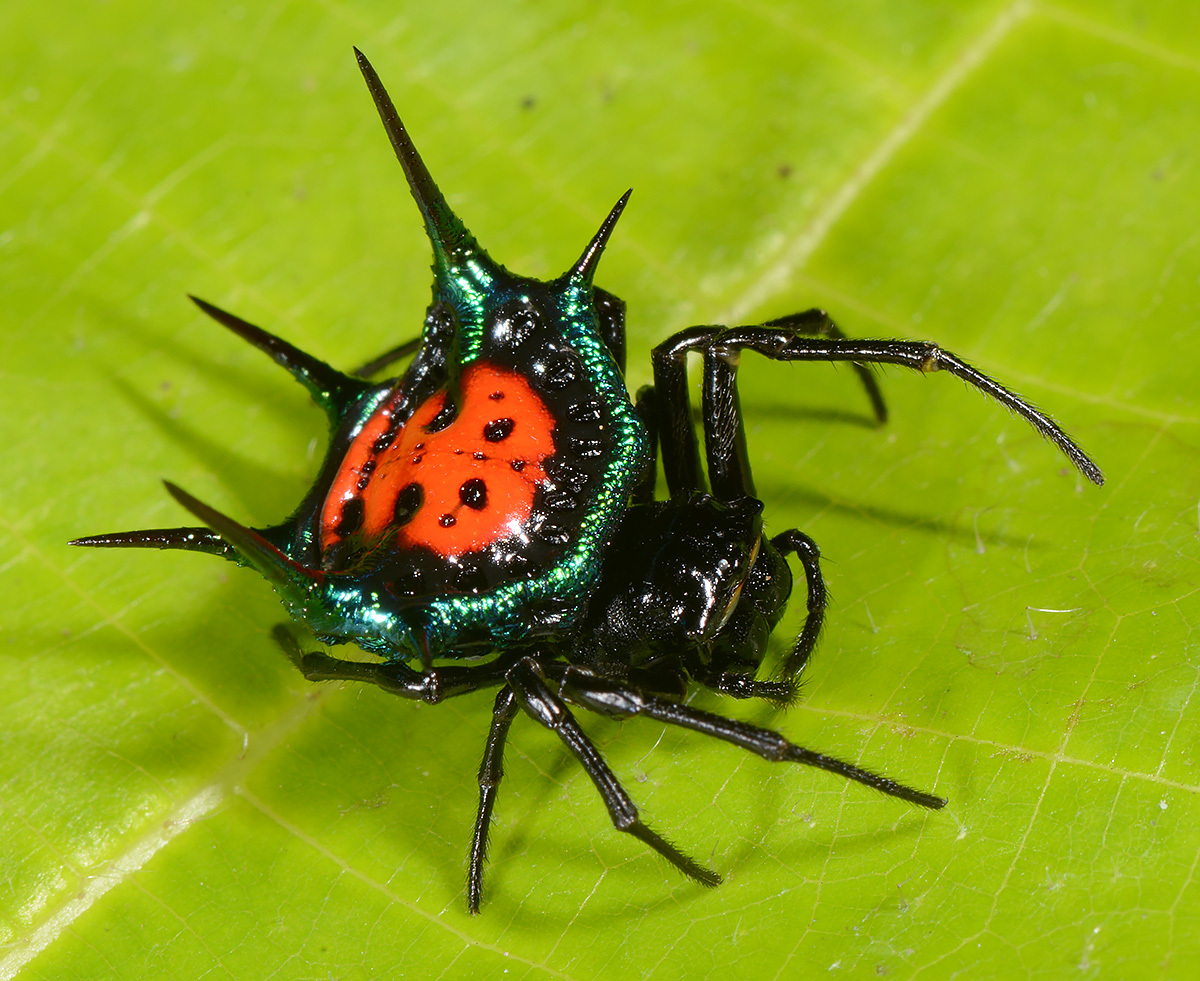
Orb-weaver spiders are widespread across Washington State and are best known for their large, circular webs that appear in gardens, forests, and near homes. These spiders vary greatly in size, with body lengths ranging from 6 to 20 millimeters depending on the species. Their colors can include brown, orange, yellow, or even patterned markings, which often provide camouflage against plants. Their large, intricate webs are highly visible, especially in the morning when dew outlines the silk strands.
Identifying orb-weavers is relatively easy due to their rounded abdomens, long legs, and the placement of their webs. Many species, such as the cross orb-weaver, display distinctive patterns on their abdomen, including cross-shaped markings. While their appearance can be striking, they are non-aggressive and are often seen sitting in the center of their webs, waiting for prey. During the evening, they are particularly active, repairing or spinning new webs.
Orb-weaver spiders prefer outdoor habitats, especially gardens, meadows, forests, and areas with vegetation that supports their large webs. They thrive in places with abundant insect activity since their webs are designed to trap flying insects such as moths, flies, and mosquitoes. While they are mostly outdoor dwellers, their webs are sometimes built on porches, balconies, and near windows, bringing them into close contact with humans.
The bite of an orb-weaver spider is very rare and usually occurs only if the spider is accidentally pressed against the skin. Their venom is mild, and bites result in little more than slight redness or swelling, comparable to a bee sting. For the most part, orb-weavers are considered beneficial, as they play an important role in reducing insect populations around homes and gardens. Their presence is more a sign of a healthy ecosystem than a cause for concern.
Jumping Spiders (Salticidae family)

Jumping spiders are among the most fascinating arachnids in Washington State, known for their distinctive movements and curious behavior. These spiders are small, usually ranging from 4 to 12 millimeters in body length, but they make up for their size with agility and excellent vision. Their compact bodies, short legs, and large front eyes give them a unique, almost endearing appearance compared to other spiders. They do not spin traditional webs for catching prey but instead rely on their jumping ability to ambush insects.
Identifying jumping spiders is relatively easy because of their large, forward-facing eyes and jerky, hopping movements. Many species are black or brown with iridescent scales, giving them a shiny or metallic appearance under sunlight. Some species display white or brightly colored markings, making them stand out against surfaces. Their habit of pausing and observing humans with their large eyes makes them one of the few spiders people describe as “cute” or “alert.”
Jumping spiders can be found in a wide variety of habitats across Washington, including gardens, grassy fields, forest edges, and even indoors. They are often seen on walls, fences, window sills, and plants, where they actively hunt for flies, ants, and small insects. Unlike web-building spiders, they create small silk retreats or draglines for safety while they move about. This adaptability allows them to thrive in both natural and urban settings.
Bites from jumping spiders are rare and usually occur only if they are handled roughly. Their venom is not dangerous to humans, and symptoms typically include mild redness, slight swelling, or minor irritation that disappears quickly. Because they actively hunt pests, they are considered beneficial around homes and gardens. For most people, the presence of jumping spiders is more of a curiosity than a threat.
Wolf Spiders (Lycosidae family)
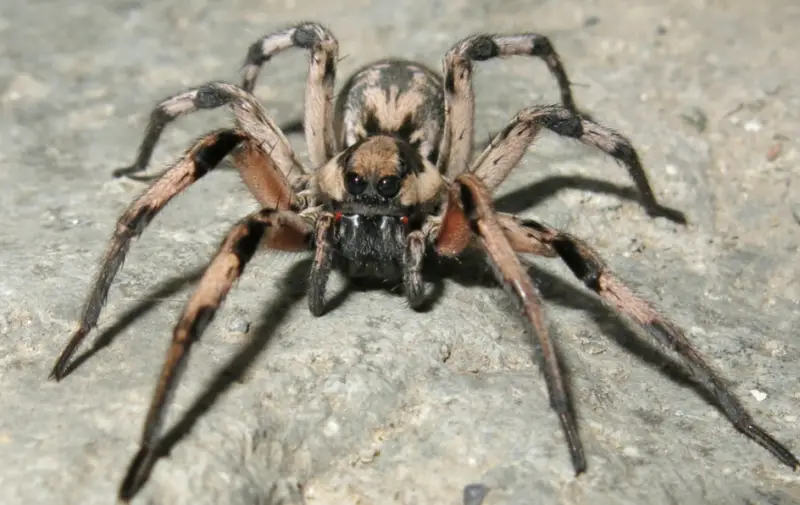
Wolf spiders are robust, ground-dwelling hunters that are widespread throughout Washington State. They range in size from 10 to 35 millimeters in body length, with long legs and a hairy appearance that makes them look intimidating. Their coloration is usually brown, gray, or black with subtle patterns that provide camouflage against soil and vegetation. Unlike web-building spiders, wolf spiders chase down prey using speed and strength.
Identification of wolf spiders can be made by their large eyes arranged in three rows, with two particularly large eyes on top of the head. These eyes reflect light, causing a noticeable shine at night when illuminated with a flashlight. Their sturdy bodies and swift movements distinguish them from similar ground spiders. Females are often seen carrying an egg sac attached to their spinnerets, and later, young spiderlings ride on the mother’s back until they are old enough to disperse.
Wolf spiders live in a variety of environments, including grasslands, forests, agricultural fields, and even urban backyards. They are ground hunters, often hiding under rocks, logs, or leaf litter during the day and becoming active at night. Unlike many spiders, they do not spin elaborate webs but may dig burrows or create silk-lined retreats. Their ability to adapt to different habitats makes them one of the most common spiders encountered across the state.
Bites from wolf spiders can occur if they are accidentally provoked or pressed against the skin. While their bite can be painful due to their strong fangs, the effects are not medically significant. Symptoms usually include temporary pain, mild swelling, and localized redness. Wolf spiders are not aggressive toward humans and generally avoid contact. Their ecological role as insect predators makes them important in maintaining balanced ecosystems.
Western Black Widow (Latrodectus hesperus)
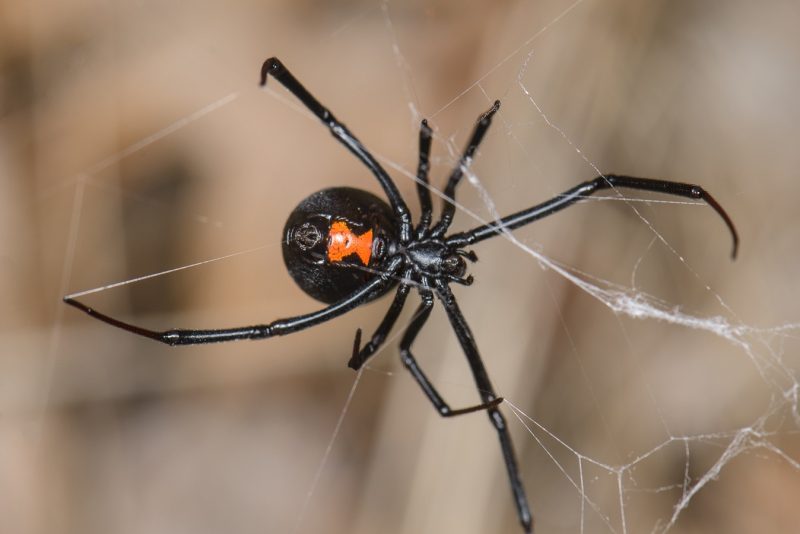
The western black widow is the most medically significant spider in Washington State, although it is relatively rare compared to other species. Adult females are easily recognized by their shiny black bodies and the iconic red hourglass marking on the underside of the abdomen. They typically measure about 8 to 10 millimeters in body length, with long, slender legs. Males are smaller, lighter in color, and less frequently encountered.
Identification of a black widow is straightforward due to the glossy black appearance and the distinctive red or orange marking. However, immature females may have mottled brown and black patterns before they develop their full adult coloration. Their tangled, irregular webs are often found in dark, undisturbed areas such as woodpiles, sheds, crawl spaces, and outdoor debris. They prefer sheltered locations that protect them from predators and provide hunting grounds for insects.
In Washington, western black widows are more commonly found in the drier, central and eastern regions of the state, though isolated populations may exist elsewhere. They favor warm, sheltered habitats and are rarely seen in heavily populated urban areas. Their secretive lifestyle means that people often encounter them only when moving objects or cleaning out storage areas where they have built their webs.
The bite of a western black widow can be serious and requires medical attention. Symptoms may include intense pain spreading from the bite site, muscle cramps, sweating, and nausea. While fatalities are extremely rare, the venom is neurotoxic and can cause severe discomfort for several days. Prompt medical care ensures recovery, and antivenom is available in severe cases. Despite their reputation, black widows are not aggressive and usually bite only in self-defense.
Conclusion
Spiders in Washington State are often misunderstood, with many people fearing them more than necessary. While several species, such as the hobo spider, giant house spider, yellow sac spider, orb-weavers, jumping spiders, wolf spiders, and the western black widow, are capable of biting, most pose little to no real danger. Their bites are generally mild, comparable to bee stings, and often occur only in self-defense when they are pressed against the skin.
Each of these spiders plays an important ecological role in controlling insect populations. Gardeners, homeowners, and outdoor enthusiasts benefit from their presence, even if their sudden appearances can be startling. Learning how to identify these spiders and understanding their typical behaviors can reduce fear and help prevent unnecessary extermination of these beneficial creatures.
Only the western black widow requires special caution, as its venom can cause more serious reactions. Still, encounters are rare, and black widows are not aggressive by nature. By being aware of their preferred habitats and exercising caution when working around woodpiles, sheds, or storage areas, people can greatly minimize the risk of bites.
FAQs about Biting Spiders in Washington State
Are hobo spiders in Washington dangerous?
No. Although they were once believed to cause necrotic wounds, more recent research shows their bites are not medically significant. Most reactions are mild, involving slight redness or itching.
Where are black widows found in Washington?
Western black widows are more common in central and eastern Washington, particularly in dry, warm environments such as barns, sheds, and woodpiles. They are rarely encountered in dense urban areas.
Do giant house spiders bite humans?
Yes, but rarely. Giant house spiders are more likely to run away when disturbed. Their bites may cause minor pain or swelling but are not dangerous.
How can I avoid spider bites in my home?
To reduce the chances of spider encounters, keep storage areas tidy, seal cracks around doors and windows, remove clutter, and wear gloves when handling firewood, boxes, or debris where spiders may hide.
Are orb-weaver spiders harmful?
No. Orb-weavers are harmless to humans and rarely bite. They are beneficial spiders that help control flying insects around gardens and homes.

